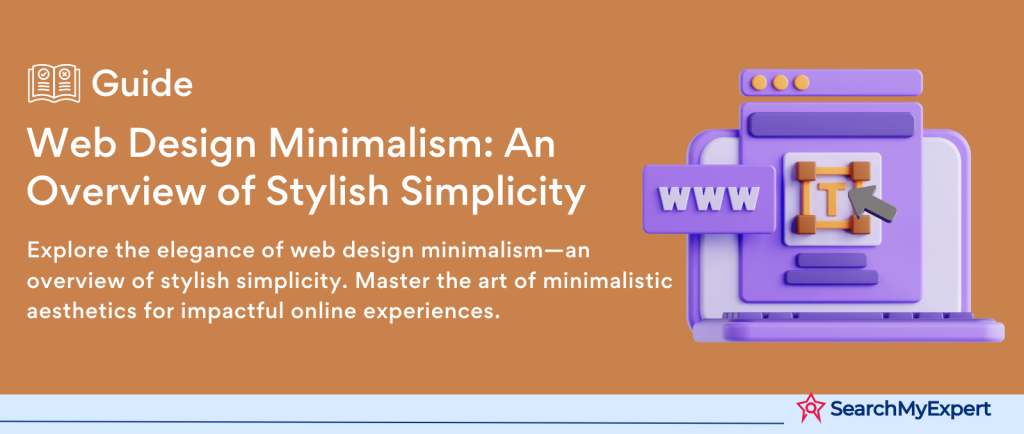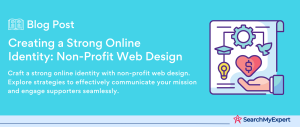Minimalist Web Design
What is Minimalist Web Design?
Minimalist web design is an approach that emphasizes simplicity and functionality. It strips away all unnecessary elements and focuses on the essentials. This style of design is rooted in the age-old adage, “less is more.” Minimalist web design uses clean lines, ample white space, limited color palettes, and bare-bones graphics. The goal is to create an interface that’s uncluttered, easy to navigate, and puts content at the forefront.
Benefits of Minimalist Web Design
- Improved User Experience:
Minimalist design prioritizes user experience (UX). With fewer distractions, users find what they need quickly and easily. Navigation becomes intuitive, and the overall user journey is streamlined. - Increased Website Performance: Fewer elements mean faster load times. A minimalist website is often lightweight and optimized, leading to better performance across various devices and platforms.
- Enhanced Visual Appeal:
Minimalism is aesthetically pleasing. It offers a modern and elegant look that can make a website stand out. The use of white space and minimal elements can create a powerful visual impact. - Better Brand Perception:
A minimalist website reflects a brand’s confidence and clarity. It communicates a message of professionalism and sophistication, enhancing brand perception and credibility.
Planning Your Minimalist Website
Define Your Goals and Target Audience
Understanding your goals and knowing your audience is crucial. Are you aiming to increase sales, generate leads, or provide information? Your target audience’s preferences and behaviors should shape your website’s design and content.
Identify the Essential Elements of Your Website
Determine what’s absolutely necessary. Every element on your site should have a purpose. Whether it’s content, images, or functionality, if it doesn’t add value, it doesn’t belong in a minimalist design.
Choose a Simple and Functional Web Design Platform
Select a platform that offers simplicity and flexibility. Platforms like WordPress, Squarespace, or Wix offer clean, minimalist templates that are easy to customize and maintain.
Select a Clean and Modern Theme or Template
Opt for a theme that embodies minimalist principles. Look for designs with ample white space, limited color schemes, and straightforward navigation. The theme should be responsive and adapt well to different devices.
Creating a Minimalist Layout for Your Website
In minimalist web design, the layout is where the magic happens. It’s the foundation that holds your content, design elements, and functionalities together in a harmonious balance. Let’s explore how to create a minimalist layout that’s both aesthetically pleasing and functionally efficient.
Use a Grid System to Organize Your Content
A grid system is the backbone of any well-structured web design. It provides a guide for aligning elements, ensuring consistency and coherence across your website.
- Flexibility and Consistency: Grids offer a flexible way to organize content while maintaining a consistent look and feel. This consistency is key in minimalist design, as it reinforces the overall sense of order and clarity.
- Responsiveness:
A well-implemented grid system makes your design more adaptable to different screen sizes, ensuring a seamless experience across devices.
Limit the Number of Columns and Sections
Minimalist design thrives on the principle of ‘less is more’. Limiting the number of columns and sections helps in creating a focused and clean layout.
- Focus on Content: Fewer columns mean more emphasis on the content. It allows users to concentrate on what’s important without getting overwhelmed by too many choices or distractions.
- Simplicity in Navigation:
A simpler structure makes navigation more intuitive. Users can easily find what they are looking for, enhancing the overall user experience.
Emphasize White Space and Negative Space
White space, often misunderstood as ’empty space’, is a crucial element in minimalist design. It’s not just the absence of content; it’s a powerful design tool.
- Breathing Room:
White space gives your content room to breathe. It helps in drawing attention to the elements that matter. - Aesthetic Appeal:
Proper use of white space contributes to the visual appeal of your website. It creates a sense of elegance and sophistication.
Focus on Clear Visual Hierarchy and Information Flow
Visual hierarchy guides the user’s eye through your content in a natural and logical order.
- Strategic Use of Size and Contrast: Larger elements and contrasting colors can guide the viewer’s attention. In a minimalist design, these tools should be used sparingly but effectively.
- Organized Information Flow: The layout should lead the user seamlessly from one piece of information to the next. A clear and logical flow keeps the user engaged and reduces confusion.
Creating a minimalist layout is about striking the right balance between aesthetics and functionality. It’s a deliberate exercise in choosing what to include and, more importantly, what to leave out. The goal is to create a website that’s not just visually appealing but also easy to navigate and use.
In minimalist web design, every element serves a purpose. The layout is not just a container for content; it’s an integral part of the user experience. By using a grid system, limiting columns and sections, emphasizing white space, and focusing on visual hierarchy, you can create a minimalist layout that is both beautiful and effective.
Minimalist Typography in Web Design
Typography in minimalist web design is more than just choosing a font; it’s about creating harmony, clarity, and a seamless user experience. Let’s delve into the art of minimalist typography and how it can elevate your website design.
Choose a Limited Number of Fonts
In minimalist design, less is always more, especially when it comes to fonts.
- Cohesion and Clarity:
Using a limited number of fonts ensures cohesion and clarity. It creates a visually harmonious look that is easy on the eyes. - Combining Fonts: Choose fonts that complement each other. A common practice is to pair a serif font with a sans-serif font to balance tradition and modernity.
Use Fonts That Are Easy to Read and Clear on the Screen
Readability is key in minimalist typography.
- Font Styles: Opt for fonts that are legible and clear. Sans-serif fonts like Arial, Helvetica, or Google’s Roboto are popular choices for their readability on screens.
- Contrast and Color: Ensure that the font color contrasts well with the background for maximum readability. Stick to a simple color palette that aligns with your overall design.
Pay Attention to Font Sizes and Line Spacing
The size and spacing of your text can greatly impact readability and aesthetics.
- Hierarchy Through Size:
Use different font sizes to create a hierarchy of information. Headings should stand out, followed by subheadings and then body text. - Optimal Line Spacing: Adequate line spacing (or leading) improves readability. The general rule is that line spacing should be 120%-150% of the font size.
Create a Consistent Typographical Style Throughout the Website
Consistency is crucial in minimalist design, and typography is no exception.
- Uniformity in Headers and Body Text:
Maintain a consistent style for all headers and body text across the website. This includes consistent font choices, sizes, colors, and spacing. - Responsive Typography:
Ensure that your typography is responsive and looks good on all devices. This may mean adjusting sizes and spacing for different screen sizes.
The Power of Typography in Minimalism
In minimalist web design, typography isn’t just about delivering content; it’s a design element in its own right. The right typography can convey a mood, reinforce brand identity, and guide users through your website seamlessly. Minimalist typography is about finding the perfect balance between form and function, where every typographic choice serves a purpose.
By focusing on a limited font selection, readability, font sizes, line spacing, and consistency, you can create a typographical style that enhances your minimalist design. This approach not only improves the aesthetics of your website but also its usability and overall user experience.
Minimalist typography is an exercise in restraint and precision. It requires a keen eye for detail and a deep understanding of how typography interacts with other elements of design. It’s about creating a visual language that speaks clearly and elegantly, with as few words as possible.
Minimalist Visuals in Web Design
Visuals are a powerful tool in web design, but when it comes to minimalism, the approach is different. Minimalist visuals are not about quantity but quality and relevance. This section explores how to effectively incorporate visuals into a minimalist website.
Use High-Quality Images and Graphics
In a minimalist design, every visual element must be chosen with care.
- Quality over Quantity:
Since minimalist designs use fewer visuals, the ones you choose must be high-quality to make a strong impact. - Relevance and Purpose: Each image or graphic should serve a purpose, whether it’s to convey a message, evoke an emotion, or guide the user’s attention.
Less is More: Use Visuals Sparingly and Only When Necessary
The minimalist mantra of ‘less is more’ is particularly true for visuals.
- Strategic Placement:
Use visuals strategically. Each visual should enhance the user experience, not distract from it. - Balancing Act: It’s a delicate balance between using enough visuals to create interest but not so many that it clutters the design.
Apply Consistent Image Styling and Editing
Consistency in image styling is crucial in minimalist design.
- Unified Look and Feel:
Consistent styling ensures that all visuals complement each other and the overall design of the website. - Editing Techniques:
Use similar filters, cropping styles, and color adjustments to maintain a cohesive aesthetic.
Consider Using SVG Icons for Visual Elements
SVG (Scalable Vector Graphics) icons are an excellent choice for minimalist websites.
- Scalability and Quality: SVG icons retain their quality at any size, making them ideal for responsive designs.
- Customization and Efficiency:
SVGs are easily customizable and typically have smaller file sizes compared to traditional image formats, contributing to faster website load times.
The Role of Visuals in Minimalist Design
In minimalist web design, visuals are not just decorations; they are integral components that communicate messages and guide user interactions. The key is to use visuals in a way that adds to the user experience without overwhelming it.
- Focus on Functionality: Each visual element should have a clear function, whether it’s to draw attention to a key piece of content, illustrate a concept, or provide navigation cues.
- Emotional Impact: Minimalist visuals can create a strong emotional impact. A single, well-chosen image can convey more than a dozen mediocre ones.
- Integration with Other Elements:
Visuals should work in harmony with typography, color schemes, and other design elements to create a cohesive and seamless user experience.
By using high-quality images and graphics, employing them sparingly, applying consistent styling, and considering SVG icons, you can create a minimalist visual design that is both beautiful and functional. This approach will ensure that your website is not just visually appealing but also effective in communicating your message and engaging users.
Minimalist visuals are about making every pixel count. It’s about using visuals not just for the sake of having them, but because they add real value to the design and the user experience. In the world of minimalist design, the visuals you choose not to use are just as important as the ones you do.
Minimalist Interaction Design in Web Development
Minimalist interaction design focuses on creating a user-friendly and intuitive experience. It’s about simplifying the way users interact with your website, making it as efficient and enjoyable as possible. Let’s delve into how minimalist principles apply to interaction design.
Keep Website Animations and Transitions Subtle and Purposeful
Animations and transitions are powerful tools, but in minimalism, they should be used sparingly.
- Enhance User Experience: Subtle animations can guide the user’s attention and improve the overall experience. For instance, a gentle fade or slide can indicate a change or a new element on the page.
- Avoid Distractions:
Excessive or elaborate animations can be distracting. The key is to use animations that enhance, not detract from, the user experience.
Use Clear and Concise Calls to Action (CTAs)
CTAs are essential in guiding users towards desired actions, such as making a purchase or signing up for a newsletter.
- Simplicity in Messaging: Keep your CTAs clear and concise. Users should immediately understand what action you’re prompting them to take.
- Visual Distinction: Make sure your CTAs stand out without being overbearing. This can be achieved through size, color, or placement, but remember to keep it in line with the minimalist aesthetic.
Optimize Website Navigation for Ease of Use
Navigation is a critical component of interaction design, especially in a minimalist website.
- Intuitive Navigation:
Users should be able to navigate your website effortlessly. This means having a well-structured menu, a logical page hierarchy, and clear labels. - Minimal Menu Items: Overloading your menu with too many options can overwhelm users. Stick to essential items and consider using a hamburger menu for mobile versions.
Make Sure the Website is Responsive and Mobile-Friendly
In today’s digital age, a website must perform flawlessly across all devices.
- Responsive Design: Your website should automatically adjust to different screen sizes and resolutions, ensuring a seamless experience on desktops, tablets, and smartphones.
- Mobile-First Approach:
With more users accessing websites on mobile devices, a mobile-first approach can be beneficial. This means designing for smaller screens first and then scaling up for larger screens.
Integrating Minimalism in Interaction Design
Minimalist interaction design is about removing unnecessary complexities and focusing on what’s essential. It’s not just about the visual aspect but also how users interact with your website.
- Purposeful Interactions: Every interactive element should serve a clear purpose. Whether it’s a button, link, or form, it should be designed with the user’s needs and goals in mind.
- Consistent User Experience:
Consistency in interactions helps users learn how to navigate your website more quickly. This includes maintaining a consistent layout, interaction patterns, and visual cues.
By keeping animations and transitions subtle, using clear CTAs, optimizing navigation, and ensuring responsiveness, you can create a minimalist interaction design that is not only visually appealing but also highly functional. This approach not only enhances the aesthetics of your website but also its usability, accessibility, and overall user satisfaction.
In minimalist interaction design, every decision, from the placement of a button to the transition between pages, is made with the user in mind. It’s about creating an experience that feels intuitive, effortless, and engaging, helping users achieve their goals with minimal friction.
Maintaining Your Minimalist Website
A minimalist website, like any other, requires regular maintenance to ensure it stays relevant, functional, and engaging. Here’s a comprehensive guide on how to maintain your minimalist website effectively.
Regularly Review and Update Your Website Content
Content is the heart of your website. Keeping it fresh and updated is crucial.
- Stay Relevant:
Regularly update your website with new and relevant content to keep your audience engaged and informed. - Reflect Brand Evolution:
As your brand evolves, your website should too. Ensure that your content aligns with your current brand message and values.
Remove Outdated or Irrelevant Information
Minimalism is about keeping only what’s necessary.
- Declutter Regularly:
Periodically review your website to remove or update outdated content. This helps maintain the minimalist integrity of your site. - Quality Over Quantity: Every piece of content should add value. If it doesn’t serve a purpose, it’s better to remove it.
Test Your Website on Different Devices and Browsers
With the variety of devices and browsers used today, cross-compatibility is essential.
- Consistent User Experience:
Ensure that your website offers a consistent experience across different devices and browsers. This includes testing for mobile responsiveness, load times, and interactive elements. - Regular Testing: Technologies and standards evolve, so regular testing is necessary to ensure your website remains compatible and performs well.
Monitor Website Performance and User Engagement
Performance monitoring is key to understanding how your website is being used and how it’s performing.
- Analytics Tools: Use tools like Google Analytics to track user engagement, page views, bounce rates, and other important metrics.
- Performance Optimization: Monitor your website’s loading speed and optimize as necessary. A fast-loading website is crucial, especially in a minimalist design where efficiency is a priority.
Proactive Website Maintenance
Maintaining a minimalist website isn’t just about fixing what’s broken. It’s about being proactive in keeping your site relevant, engaging, and efficient.
- Stay Updated with Trends: Keep an eye on the latest web design and technology trends. This will help you keep your website modern and functional.
- User Feedback: Pay attention to user feedback. This can be a valuable source of information for improving your website.
- Security Updates:
Regularly update your website’s security features to protect against vulnerabilities.
Conclusion
Effective maintenance of a minimalist website involves a combination of regular updates, decluttering, cross-compatibility testing, performance monitoring, and staying abreast of new trends and technologies. By doing so, you ensure that your website not only maintains its minimalist charm but also remains effective and relevant in the ever-evolving digital landscape.
Let our Web Design Company redefine your online presence.
Table of Contents
Toggle






